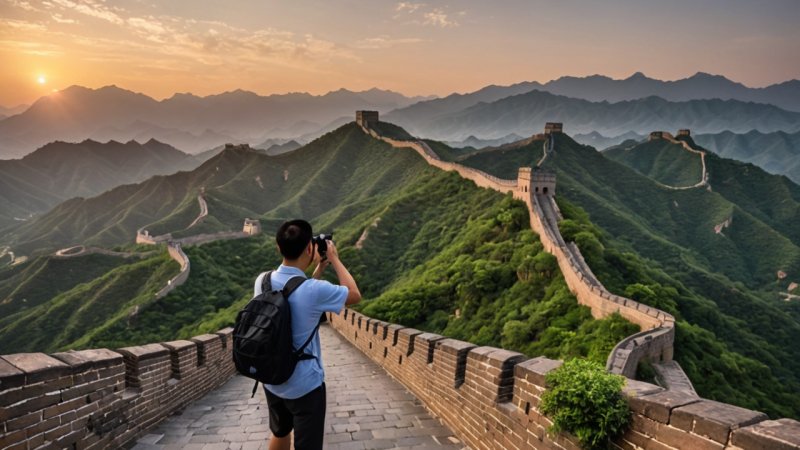The Great Wall of China stands as one of the most iconic structures in the world, stretching over 13,000 miles across northern China. This remarkable feat of engineering is not just a wall; it is a testament to the ingenuity and determination of the Chinese people throughout history. For photographers, the Great Wall offers an unparalleled opportunity to capture stunning landscapes, rich cultural heritage, and the interplay of light and shadow across its ancient stones. Whether you're an amateur enthusiast or a seasoned professional, understanding the nuances of photographing this magnificent structure can enhance your travel experience and yield breathtaking results. In this article, we will explore the best locations, tips for capturing the perfect shot, and unique experiences that will help you immortalize the Great Wall in your photography.
Understanding the Great Wall: A Historical Perspective
Before setting out to capture the Great Wall through your lens, it is essential to appreciate its historical significance. Built primarily during the Ming Dynasty, the Great Wall was constructed as a defense mechanism against invasions. Today, it serves as a symbol of China's enduring strength and perseverance. The wall's architectural diversity varies from region to region, with some parts featuring watchtowers, while others are built with rammed earth. Each section has its own unique charm and story, which can inspire your photography.
Best Locations for Photography
Though the Great Wall spans several provinces, not all sections are equally photogenic or accessible. Here are some of the top locations to consider when planning your photographic journey:
- Badaling: This is the most popular and well-preserved section, making it ideal for capturing stunning images with a backdrop of lush mountains. However, it can get crowded, so consider visiting early in the morning.
- Mutianyu: Known for its breathtaking views and fewer tourists, Mutianyu features a beautifully restored section that allows for both panoramic shots and close-ups of the intricate stonework.
- Juyongguan: This section offers dramatic landscapes and is surrounded by steep mountains. Its ancient watchtower provides an excellent vantage point for capturing the wall snaking through the hills.
- Simatai: If you're looking for a more rugged, untouched experience, Simatai is a great choice. Its steep inclines and crumbling watchtowers lend a sense of adventure to your photography.
- Gubeikou: For those seeking solitude, Gubeikou is less frequented by tourists. This section showcases the raw beauty of the Great Wall and offers opportunities for unique compositions.
Timing Your Visit for Optimal Lighting
Lighting can make or break a photograph, and the Great Wall is no exception. The golden hours—shortly after sunrise and just before sunset—are ideal for capturing the wall bathed in warm, soft light. During these times, the shadows cast by the wall create depth and texture, enhancing your images. If you venture to the wall on a cloudy day, the diffused light can yield striking results, allowing for even exposure without harsh shadows.
Technical Tips for Capturing the Great Wall
To make the most of your photographic journey, consider these technical tips:
- Use a Tripod: A tripod is essential for long exposure shots, especially during low-light conditions. It will help you achieve sharp images without camera shake.
- Experiment with Angles: Don’t be afraid to get creative with your compositions. Shoot from different angles and heights to capture the wall's grandeur and the surrounding landscapes.
- Incorporate Foreground Elements: Including elements such as trees, flowers, or people in the foreground can add depth and context to your photographs.
- Play with Depth of Field: Use a shallow depth of field to isolate specific details of the wall, or a wide depth of field to capture sweeping landscapes.
Unique Experiences to Enhance Your Photography
Your journey to the Great Wall can be enriched with unique experiences that will not only assist you in capturing breathtaking images but also deepen your appreciation for this historic monument:
- Sunrise Hike: Consider starting your day with a hike to a less-traveled section for sunrise. The tranquility of the early morning combined with the soft light can create a magical atmosphere.
- Photography Workshops: Participate in a photography workshop led by local experts who can provide guidance on capturing the nuances of the Great Wall.
- Night Photography: Some sections of the Great Wall are open for night visits. Experimenting with long exposure shots against a starry sky can yield mesmerizing results.
Respecting the Cultural Heritage
While capturing the beauty of the Great Wall, it is crucial to respect its cultural and historical significance. Stay on marked paths, avoid climbing on unstable sections, and be mindful of other visitors. Engaging with local historians or guides can enhance your understanding and appreciation of the wall, making your photography even more meaningful.
Conclusion
The Great Wall of China is not just a monument; it is a canvas awaiting your creative touch. With its rich history, stunning landscapes, and unique photographic opportunities, it offers an unparalleled experience for photographers. By choosing the right locations, timing your visit for optimal lighting, and employing effective techniques, you can capture the essence of this world wonder. As you embark on your photographic journey, remember to respect the wall’s cultural heritage and immerse yourself in the stories it has to tell. Your photographs will not only reflect the beauty of the Great Wall but also the spirit of the journey that brought you there.






